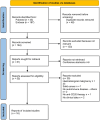Severe enterovirus infections in patients with immune-mediated inflammatory diseases receiving anti-CD20 monoclonal antibodies
- PMID: 38772678
- PMCID: PMC11328644
- DOI: 10.1136/rmdopen-2023-004036
Severe enterovirus infections in patients with immune-mediated inflammatory diseases receiving anti-CD20 monoclonal antibodies
Abstract
Objective: Patients with X linked agammaglobulinemia are susceptible to enterovirus (EV) infections. Similarly, severe EV infections have been described in patients with impaired B-cell response following treatment with anti-CD20 monoclonal antibodies (mAbs), mostly in those treated for haematological malignancies. We aimed to describe severe EV infections in patients receiving anti-CD20 mAbs for immune-mediated inflammatory diseases (IMIDs).
Methods: Patients were included following a screening of data collected through the routine surveillance of EV infections coordinated by the National Reference Center and a review of the literature. Additionally, neutralising antibodies were assessed in a patient with chronic EV-A71 meningoencephalitis.
Results: Nine original and 17 previously published cases were retrieved. Meningoencephalitis (n=21/26, 81%) associated with EV-positive cerebrospinal fluid (n=20/22, 91%) was the most common manifestation. The mortality rate was high (27%). EV was the only causal agents in all reported cases. Patients received multiple anti-CD20 mAbs infusions (median 8 (5-10)), resulting in complete B-cell depletion and moderate hypogammaglobulinemia (median 4.9 g/L (4.3-6.7)), and had limited concomitant immunosuppressive treatments. Finally, in a patient with EV-A71 meningoencephalitis, a lack of B-cell response to EV was shown.
Conclusion: EV infection should be evoked in patients with IMIDs presenting with atypical organ involvement, especially meningoencephalitis. Anti-CD20 mAbs may lead to impaired B-cell response against EV, although an underlying primary immunodeficiency should systematically be discussed.
Keywords: B-lymphocytes; antirheumatic agents; autoimmune diseases; rituximab.
© Author(s) (or their employer(s)) 2024. Re-use permitted under CC BY-NC. No commercial re-use. See rights and permissions. Published by BMJ.
Conflict of interest statement
Competing interests: None declared.
Figures



References
MeSH terms
LinkOut - more resources
Full Text Sources
